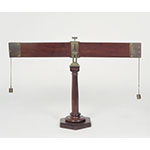This first-order lever demonstrates how the center of gravity of a balance beam should be positioned for maximum weighing sensitivity.
A wooden base holds a column with a small brass frame. The balance beam rests on a steel knife-edge supported by the frame. The beam is fitted at both ends with strips from which two small weights are suspended by cords. There are three pairs of holes in each strip to change the points of application of the weights. The fulcrum is fitted with a small dial for vertical adjustment. Through suitable changes in its position, one can show that the balance beam is most sensitive when its center of gravity lies slightly below its rotation axis. If the center coincides with the axis, the balance would be in indifferent equilibrium: every beam position is stable provided the weights are equal. When, instead, the center of gravity lies above the rotation axis, even a slight change of weight causes the beam to swing sharply. This mechanism was illustrated in 1795 by Sigaud De La Fond with a similar apparatus. Provenance: Lorraine collections.










